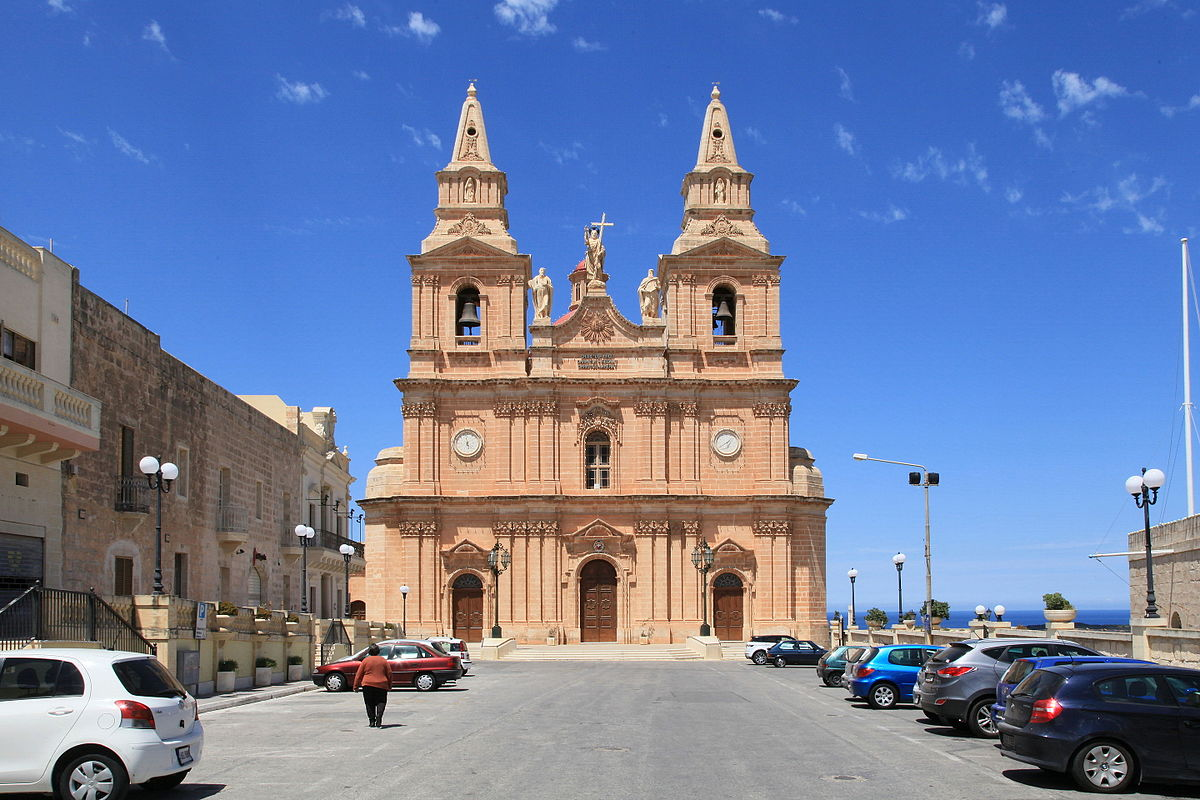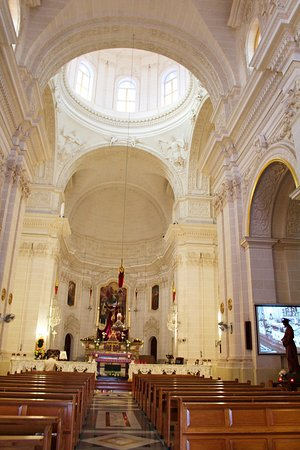Parish Church
In the late 19th century the Sanctuary was found to be too small for the Mellieha community. This time it was not enlarged but a decision was taken to build a large church.
This happened when Fr Francis Magri (1880-1907) was the parish priest of Mellieha. He took the decision to build a new church. Now there was the problem where the new church was to be built. Magri and the clergy of Mellieha wanted to be build near the sanctuary,1 so he would remain also rector. On the other hand the British Military Authorities were against it, because in case of an invasion in Mellieha bay the church would be seen.
At last a decision was taken and the new parish church was to be build where it is now near the sanctuary.1 A lot of time was taken to buy the necessary land because a number of people who had land there didn’t want to sell it. At last they were convinced to sell the land and a sum of 150 scudi was paid for this purpose.2 Meanwhile, the first stone was laid in 1883. In order to have enough money to finance this project the parish priest was forced to sell a number of silver and gold items from the sanctuary. 3

The parish priest arrived at a situation that all the gold and silver items were sold out. The offerings that were collected from every mass were all destined to finance the new parish church. Fortunately there were a number of benefactors who helped to finance the building. These were the Cathedral of Malta (£50), Tonnara Zammit (£353), Vincenzo Baldacchino (£233) and Fr. Francis Falzon Debono (£808). From 1882 to 1906 Fr Magri succeeded to collect some £1620, but a much bigger sum some 4287 was needed to build the new church. 4
The building of the new church took some seventeen years to finish, from 1881 to 1898. Inside the new parish church Fr. Magri made a number of things. A new organ was ordered from Joseph Bergamo in 1892, and its cost was 360 scudi. There were also the altars, five paintings by Jospeh Cali: the titular painting (1898),5 St. Elena (1898), St. Gaeatan (1898), Our Lady of Rosary (1899), and St. Paul. Apart from these tapestry was made to decorate the church, a canopy over the high altar and the pulpit. 6 The new church was inaugurated by Archbishop Peter Pace in 1897. 7
Now the religious services were transferred to the new parish church. But there was a lot of debt to be paid off. The parish priest Magri continued to pay these debt and also paid from his own expenses. In 1907 he became a canon of the Cathedral of Mdina. Instead of Magri was appointed Fr Charles Cortis (1908-24) as parish priest of Mellieha. He continued to pay the debts of the new parish church and he succeeded in collecting money for the building of the two belfries and five bells. Unfortunately, he was able to build only the two belfries. Cortis was too appointed canon of Mdina in 1924. 8
To many aThe nominee of a new parish priest of Mellieha took a lot of time. During this time Fr Anton Ellul acted as a vicar of the Mellieha parish church. There was also Fr. Francis Debono helping Fr. Ellul. 9
A year later, in 1925, a new parish priest was appointed for Mellieha and he was Fr. Indri Fenech, who remained parish priest for twenty-one years (1925-46). Fr. Fenech was born in Mellieha, so, he had much more interested in the Mellieha parish church. This parish priest was able to pay all the debts. The new five bells, which were constructed by the Italian foundry Aldo Barigozzi, arrived in Mellieha at this time. The five bells were named in this way: the largest one Maria Vittoria and the others San Paolo, Sant’Antonio, San Giuseppe and San Francesco. The new parish church was consecrated on 18 February 1930 by Archbishop Caruana. In the 1930s Wistinu Camilleri was ordered to make a number of statues for the façade of the parish church. 10
After the war in 1946, Fr. Francis Xuereb (1946-67) was appointed the new parish priest of Mellieha”Mellehin”, September 9 means the “Xalata”, a day in which most people go to the beach and enjoy themselves. The “Xalata” is present in all Maltese Village Festas, and nowadays can be nearly considered as another holiday.

The nominee of a new parish priest of Mellieha took a lot of time. During this time Fr Anton Ellul acted as a vicar of the Mellieha parish church. There was also Fr. Francis Debono helping Fr. Ellul. 9
A year later, in 1925, a new parish priest was appointed for Mellieha and he was Fr. Indri Fenech, who remained parish priest for twenty-one years (1925-46). Fr. Fenech was born in Mellieha, so, he had much more interested in the Mellieha parish church. This parish priest was able to pay all the debts. The new five bells, which were constructed by the Italian foundry Aldo Barigozzi, arrived in Mellieha at this time. The five bells were named in this way: the largest one Maria Vittoria and the others San Paolo, Sant’Antonio, San Giuseppe and San Francesco. The new parish church was consecrated on 18 February 1930 by Archbishop Caruana. In the 1930s Wistinu Camilleri was ordered to make a number of statues for the façade of the parish church. 10
After the war in 1946, Fr. Francis Xuereb (1946-67) was appointed the new parish priest of Mellieha
instead of Fr. Fenech. He continued to décor the new church by cladding it with marble and sculpture. For this purposes Fr. Fenech used the services of Vincenzo Bonello. 11
After Fr. Xuereb was appointed canon of Mdina, Fr. Joseph Schembri (1967-85) became the new parish priest of Mellieha. More sculpture was made in the church, but there was also some restoration made by Karmnu and his son Leli Cini.12 These totalled some £m42, 000. A number of benefactors paid the cost of the statues of Moses, Elia, St. Annie and others. A number of necessary utilities were made including fans and benches. All the glass of the church was changed with a new design made by George Fenech. 13
In 1986 a new parish priest was appointed and he was Fr. Alfred Camilleri (1986-94). During this time restoration was done in the church by Leli Cini.14 Three large artistic glass-doors design by Joseph Galea were made. Two crystal chandeliers were bought, a marble dome was made on the tabernacle and restoration of the angles and other statues that every year are mounted in the parish square.15 Much more restoration was carried out in the church during the time of the next parish priest Fr. Karm Tanti. 16
Reference :
1.Alexander Bonnici OFMConv., “Is-santwarju u l-parroċċa tul iż-żmien”, Joseph Catania (ed), Il-Mellieħa: Mal-milja taż-żmien, Mellieha Local Council, Malta, 2002, p 67.
2. Alexander Bonnici OFM Conv, Il-Mellieħa: Fid-Dawl ta grajjiet is-Santwarju u l-Parroċċa, Parroċċa tal-Mellieħa, Malta, 1994, p 115.
3. Catania (ed) ,2002, p 67
4. Bonnici, 1994, pp 115-116.
5. Catania (ed), 2002, p 68.
6. Bonnici, p 116.
7. Catania (ed), 2002, p 68.
8. Ibid, p 70
9. Ibid, p 70
10. Bonnici, 1994, pp 124-125.
11. Ibid, p 127.
12. Catania (ed), 2002, p 72.
13. Bonnici, 1994, p 129.
14. Catania (ed), 2002, p 75
15. Bonnici, 1994, p 131-132
16. Catania (ed), 2002, p 75.